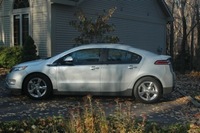2012 Chevrolet Volt Review By Steve Purdy
Learn More: EV-Motoring
Learn More: Chevrolet Specs, Comparisons and Prices - 1997-2012 Chevrolet Buyers Guide
2012 CHEVROLET VOLT
The Extended Range Electric Car
By Steve Purdy
TheAutoChannel.com
Detroit Bureau
GM put a lot of eggs in this electric car basket. Development costs ran into the billions of dollars in spite of the Volt being essentially built on the Cruze platform. Of course that platform had to be substantially modified to accommodate particularly the battery pack and a number of other differences. Championed by product boss, Bob Lutz, the Volt is intended to put GM in the electric car lead.
 |
Handling and performance are excellent, in my view. It feels like any upscale compact car. Steering is tight and smooth. Suspension is well balanced. Acceleration is better than most. And, little about the driving dynamics suggests you’re in something unconventional. The most frequent comment heard from first time drivers is about its conventional feel.
 |
The Volt is very practical in both senses, though, for my friend and colleague, Walt, who lives in Lansing. He’s always been an early adopter of technology and lives in the city where his average daily driving needs are well within the Volt’s 35- to 40-mile range. After over two months of living with his Volt he loves it. It’s rather like a video game for him as he uses the many electronic readouts to maximize his efficiency. He gets an almost obsessive thrill not buying gasoline as well as endless entertainment finding ways to get farther on a charge.
 |
Volt is designed with every efficiency GM could think of since small things add up to major savings in mileage. For example, low rolling resistance tires (in this case 215/55 Goodyear Assurance) combine with lots of aerodynamic tricks (resulting in a coefficient of drag of 0.27).
Let’s run some other numbers just a bit.
 |
Now, let’s figure you drive the car about 10,000 miles per year. This will be a second or third car for most buyers who will use it mostly for short commutes and buzzing around town. With the Cruze you would have no trouble averaging 30 mpg and we’ll figure you won’t use the gasoline engine on the Volt more than 20% of the time at a conservative average of 35 mpg. It’s rated at 37-mpg combined on gasoline only. If we figure $4.00/gallon on average (probably low if we consider the next 5 years and that the Volt needs premium fuel) you’ll spend $228 on gasoline.
The Cruze would use $1,267 worth of fuel using regular fuel at $3.80 cost assumption.
 |
That means a fuel (including cost of electrons) savings of about $575/years. The payoff period for this technology, then, is nearly 20 years. We could use many different assumptions but this is about as fair as I can make it.
If we assume the entire 10,000 miles are on electric only and we never have to buy fuel then the electric cost would be $428 making for an $839 savings or a payoff period of just about 12 years. (See Also: Electric Vehicles - Solution or Diversion?)
While it is certainly a thrill to drive regularly without buying fuel it is not enough for me to embrace yet.
Notwithstanding a recent fire in a battery pack being tested at NHTSA facility in Wisconsin, there is no reason to be concerned about safety or longevity. Lithium-ion batteries need heat management but they probably present much less hazard than a gasoline powered car. The battery pack is warranted for 100,000 miles and we have no reason to think that it wouldn’t last much longer. Additionally, speaking of safety, the IIHS rates the crashworthiness of the Volt with maximum five stars for everything but passenger side impact, which gets four stars.
The Volt in my driveway shows a sticker price of $46,165. That’s a lot of money for a small car, even considering that you don’t need gasoline. Relatively speaking, gas is still cheap as a transportation fuel, by the way. If you qualify for the federal income tax credit of $7,500 that brings it back to the price of this one to $39,145. That’s the price of the car with options. Ours has the Navigation and Premium Trim Packages along with leather wrapped steering wheel, rear camera, park assist, polished aluminum wheels and Bose premium speaker system. These all add up to around six grand without the $850 destination charge. Base price without any options is $39,145. So with the federal tax credit we’re looking at around $32,600. The base car, by the way, is quite well equipped.
The biggest factor in that cost is the lithium-ion battery packs and all the technology that goes with them. The batteries must be cooled and heated to keep maximum efficiency and they must be controlled by a computer system that would put to shame anything we put in space 20 years ago.
 |
As a practical matter, of course, people won’t buy the Volt to save money. Buyers, like my friend Walt, are early adopters who love technology and want to be the first on their block to own something so innovative. Others will want to make a statement about their environmental or geopolitical concerns.
After initial customer enthusiasm prompted GM to increase production rates the first year sales of the Volt (November 2011) are running below expectations. GM just announced that the car will be going on sale in China soon and a version badged as an Opel Ampera is available in Europe.
GM is not following the famous advice of Mark Twain who said, “Put all your eggs in one basket and watch that basket!” We’ll certainly see this technology expand into many other products from GM.
© Steve Purdy, Shunpiker Productions, All Rights Reserved



